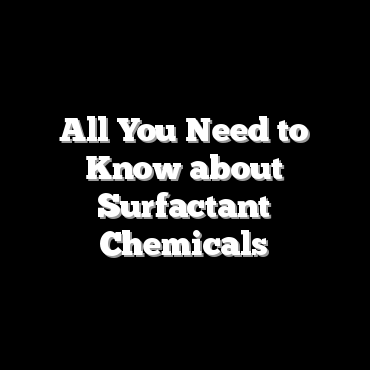Surfactant chemicals can be produced from natural as well as synthetic materials. These chemicals have versatile uses. They have the special ability to combine and mobilize different incompatible materials, such as oils, water, solvents, and fats. They are used for detergent and cleaning formulations. Certain surfactant chemicals are also used in beauty products and pharmaceuticals.
What are surfactant chemicals?
The term ‘surfactant’ has been derived from the phrase ‘Surface Active Agent’. Surfactants decrease the interfacial or surface tension between a solid and a liquid or between two liquids. They help different materials combine successfully. This ability is the reason behind their unique molecular structure. When you add surfactants to water as a part of cleaning formulation or detergent, they create structures known as ‘micelles’. These are tiny spheres of surfactant molecules that make the combination of items possible.
What are the uses of surfactant chemicals?
When you use the right surfactant chemicals, a particular process or a product becomes more efficient and more sustainable. Here are some of the uses:
Surfactant chemicals, on being added to detergents, help the detergent to get mixed into the water. They help cleaning agents to remove dirt and impurities from the surface that is being cleaned. If you do not use surfactants, soaps or detergents can never mix with water.
Surfactants are also used in lubricants like shaving foams and creams. They allow the razors to glide easily without creating any irritation.
Surfactants in car engine lubricants also help in preventing particles from getting stuck to different parts of the engine. This makes it easy for the parts to move, allowing the proper functioning of the vehicle.
What are the different types of Surfactant Chemicals?
Cationic surfactants
These surfactants have positively charged hydrophilic head groups. These are mostly used in antistatic products like hair conditioners and fabric softeners. The head group carrying a positive charge is deposited into the negatively charged fiber and hair surfaces. Cationic surfactants are also used in hard-surface disinfectants and cleaners as antimicrobial agents.
Anionic surfactants
These surfactants have a negative charge on their head groups. They provide amazing detergency properties. They can bind together particles that are positively charged, for example, oils and dirt. They lift and suspend these particles forming micelles. These kinds of surfactant chemicals are widely used in households and workplaces.
Amphoteric surfactants
Amphoteric or zwitterionic surfactants have a positive and negative charge on their head groups. This makes their total charge zero. These substances have low toxic levels. They are tolerant towards hard water and show excellent compatibility with other surfactant chemicals.
Nonionic surfactants
These surfactants do not have a charge on their head groups. Thus, they are milder. For this reason, they are used in households. Nonionic surfactants are mostly used in cosmetics and personal care products. These chemicals are also used in the agrochemical industry in the form of pesticides. They also find uses in the process of refining gas and oil. They are also commonly used in the case of coating applications.
Chemical Products Industries Also Offers Following Services:
Oxygen Removal From Natural Gas
Contact US:
Chemical Products Industries, Inc.
Phone: (800) 624-4356

